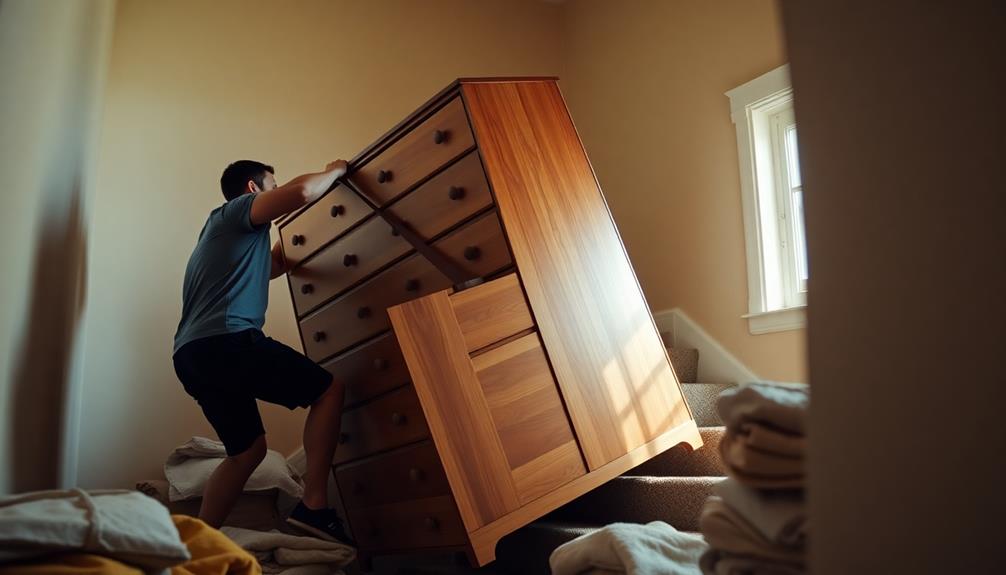To successfully transport heavy furniture up a flight of stairs, start by assessing the weight and size of the item. Ensure that pathways are clear and obstacles are removed to prevent accidents. If possible, take apart larger pieces to make them easier to handle. Utilize a stair-climbing dolly or moving straps to evenly distribute weight and minimize strain. Always use proper lifting techniques – remember to bend your knees and keep your back straight. It is advisable to have at least one helper to assist with balance and coordination. Clearly communicate your plan to avoid any mishaps. By following these methods, you will be able to navigate stairs more efficiently. Discover more efficient moving techniques for the future.
Key Takeaways
- Assess furniture weight and dimensions, and measure pathways to ensure a smooth move up the stairs.
- Utilize a stair climbing dolly for easier navigation and to reduce strain on your body.
- Disassemble large items to lighten the load and make maneuvering through tight spaces easier.
- Use proper lifting techniques and communicate clearly with partners for synchronized movements and safety.
- Take breaks during the move to avoid fatigue and ensure a safe, efficient process.
Planning Your Move
When you're planning your move, it's vital to assess the type and weight of the furniture you need to transport. Start by measuring the dimensions of each piece, along with the stairway, door frames, and landings. This guarantees everything fits and helps you avoid getting stuck during the move.
Additionally, consider the weight distribution and how to use primitive weapons for modern survival techniques, like leveraging tools or using your body weight effectively, to assist in moving heavy items.
Next, plan your route carefully. Clear pathways by removing obstacles like rugs or clutter from the stairs and hallways. A clean path not only makes the move safer but also more efficient.
Communicate clearly with your helpers about the moving strategy. Let them know who'll lift from which end and when to pause or adjust as you navigate the stairs.
If you find you're dealing with larger items, consider disassembling them. Removing legs from tables or beds can considerably reduce their weight and make them easier to maneuver.
Disassembling Furniture
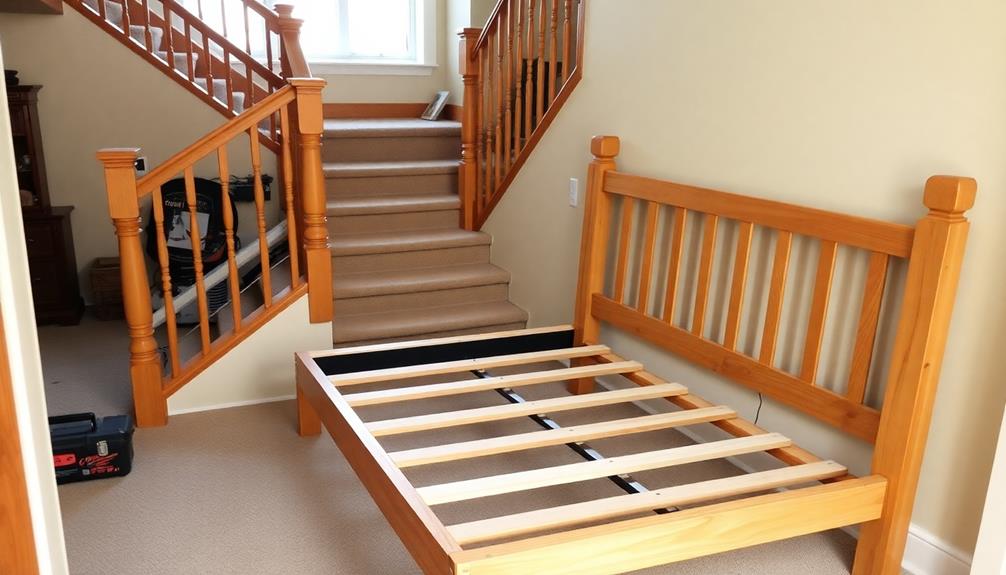
Disassembling furniture can make your moving process much easier, especially for large items like beds and dining tables. By disassembling these pieces, you greatly reduce weight, making them easier to navigate stairs and tight spaces.
Additionally, remember that certain conditions, like ear pressure during colds, can affect your ability to lift heavy furniture efficiently. Start by removing legs, drawers, and any other detachable parts to create a more manageable load.
As you take things apart, keep track of screws and small components by storing them in labeled bags. This way, you'll guarantee easy reassembly after the move.
For items that can't be disassembled, like couches, consider using protective covers to prevent damage during transportation.
Before you attempt to move anything, always measure the dimensions of disassembled parts. This step is vital to confirm they'll fit through doorways and staircases without a hitch.
By taking the time to disassemble your furniture properly, you'll not only make the moving process smoother but also protect your items from potential damage.
Necessary Tools and Equipment
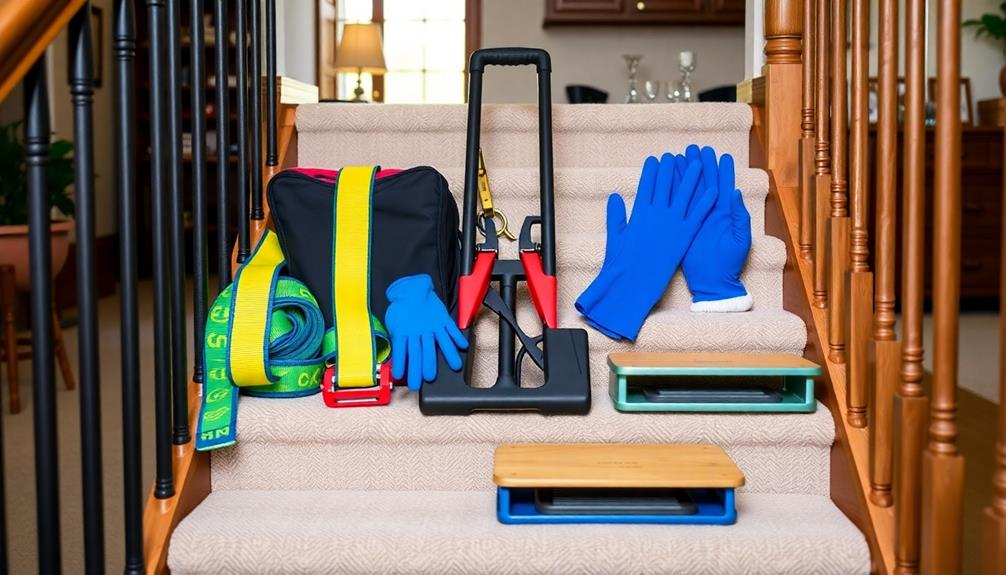
To move heavy furniture up stairs safely, you'll need some essential tools and equipment. A stair climbing dolly, moving straps, and lifting cushions can make the process much easier and reduce the risk of injury.
Additionally, employing professional cleaning methods can help maintain the condition of the furniture during the move. This ensures that your items stay in top condition, reducing the risk of damage or wear that might diminish their value. If you’re planning to sell furniture in your area after the move, having well-maintained pieces can help attract potential buyers and secure a better price. Proper care during transportation not only protects your investment but also makes reselling a smoother process. Moreover, keeping your furniture in pristine condition can streamline the selling process when you’re ready to part with it. When you *sell your furniture nearby*, high-quality, well-preserved items are more likely to appeal to local buyers who are searching for attractive, durable pieces. This can lead to quicker sales and potentially higher returns on your investment.
Let's explore the benefits of each of these items to guarantee a smoother moving experience.
Essential Moving Straps
Using essential moving straps can make a vital difference when tackling the challenge of moving heavy furniture up stairs. These moving straps are specifically designed to distribute weight evenly, greatly reducing strain on your back and arms.
With various styles available, such as shoulder straps, you can easily team up with a partner to lift bulky items together, making stair climbing much more manageable.
Investing in heavy-duty straps can support weights of up to 600 pounds, making them ideal for large furniture pieces like sofas and dressers.
When using these straps, maintaining proper posture is fundamental. Stand upright, engage your core, and guarantee both you and your partner are in sync for coordinated lifting.
This technique not only enhances safety but also maximizes efficiency during your moving job.
Stair Climbing Dolly
A stair climbing dolly can be a game-changer when you're faced with the challenge of moving heavy furniture up stairs. Designed with tracks or specialized wheels, this tool allows you to navigate stairs with minimal effort, greatly reducing strain on your body.
With its sturdy frame and secure platform, you can confidently transport your heavy items without worrying about stability or accidents.
Many stair climbing dollies feature a built-in braking system, enhancing transport safety by preventing uncontrolled descents down stairs. This is essential when you're dealing with bulky pieces that can be hard to manage.
Plus, with a load capacity of up to 600 pounds, you can easily move heavy furniture upstairs and tackle appliances with ease.
Renting a stair climbing dolly typically costs between $25 and $50 per day, making it a cost-effective solution for your moving needs without the burden of purchasing expensive equipment.
By using a stair climbing dolly, you can guarantee efficient moving while protecting yourself and your belongings.
Lifting Cushions Benefits
While a stair climbing dolly simplifies transporting heavy furniture up stairs, lifting cushions can further enhance your moving experience. These airbag lifters create space under heavy objects, making it easier to slide or lift items safely and efficiently, especially during stair navigation. Each lifting cushion supports up to 300 pounds, allowing you to elevate heavy furniture without straining your back.
The inflatable design provides quick inflation and deflation, enabling efficient use in tight spaces where maneuverability is essential. By using lifting cushions, you can considerably reduce the physical effort required during a move. They help reduce the strain on your body and promote safer handling practices, minimizing the risk of injury.
Additionally, lifting cushions reduce friction, allowing furniture to glide smoothly across surfaces. This feature helps protect your floors from scratches, preserving your home while you move.
Incorporating lifting cushions into your moving strategy means you'll work smarter, not harder, ensuring your heavy items are transported with ease. So, consider investing in these beneficial tools for a more efficient and safer furniture-moving experience.
Safety Precautions
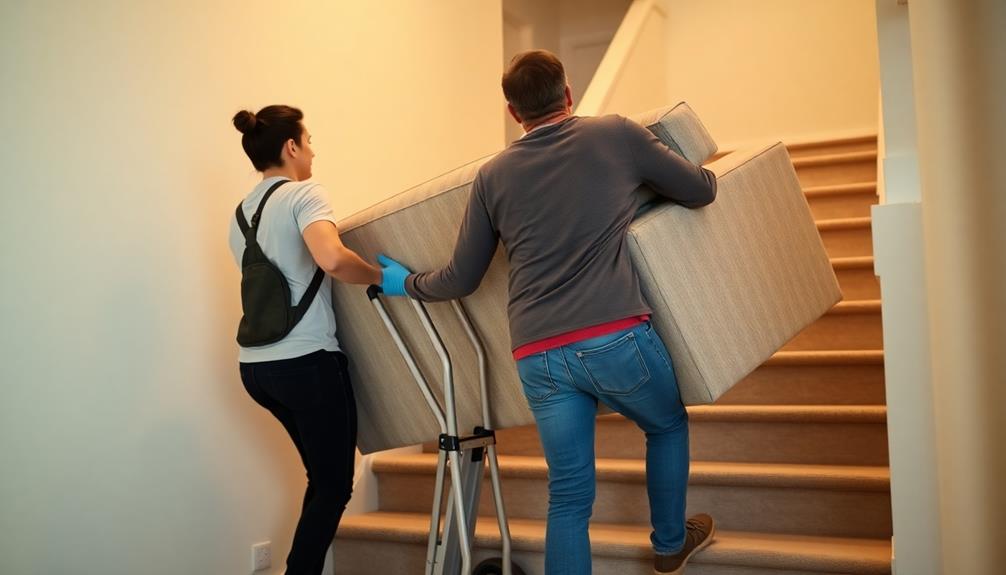
Guaranteeing safety is vital when moving heavy furniture up stairs. Always enlist at least one additional person to help you. This way, you can work together to handle the load and avoid accidents. Use proper lifting techniques, like bending at the knees and keeping your back straight, to reduce the risk of injury. Position your feet shoulder-width apart for better balance and stability.
Before starting, inspect the stairs for stability. Remove any loose items or obstacles to avoid tripping hazards. Secure the furniture with straps or ropes to prevent it from slipping or falling during the move. These tools that can help guarantee that you maintain control over the furniture at all times.
As you move, don't forget to take breaks as needed. Fatigue can lead to accidents, so it's vital to rest and recharge throughout the process. If you feel overwhelmed, don't hesitate to ask for more help.
Prioritizing safety won't only protect you but also guarantee that your furniture arrives at its destination without damage.
Lifting Techniques
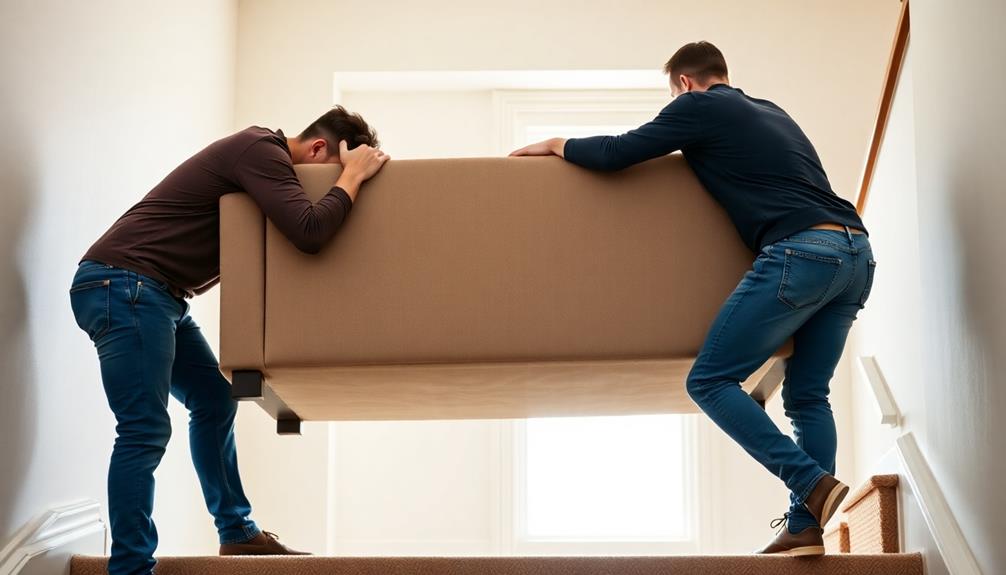
Moving heavy furniture up stairs requires not just teamwork and safety precautions but also the right lifting techniques. To guarantee you lift efficiently and safely, follow these essential tips:
| Technique | Description |
|---|---|
| Stable Base | Keep your feet shoulder-width apart for balance. |
| Bend Your Knees | Lift with your legs to prevent back strain. |
| Engage Your Core Muscles | Support your spine and distribute the weight. |
Always remember to keep your back straight while bending your knees. This helps maintain control and reduces the risk of injury. Use a team approach by coordinating with a partner, where one person is at the top and another at the bottom of the furniture. This guarantees everyone is on the same page while maneuvering the stairs.
As you lift, take small deliberate steps. This allows you to adjust as needed and maintain balance while moving around obstacles. Finally, avoid twisting your body during the lift; instead, pivot your feet to change direction. By following these lifting techniques, you'll guarantee a safer and more efficient move up the stairs.
Moving Up Stairs
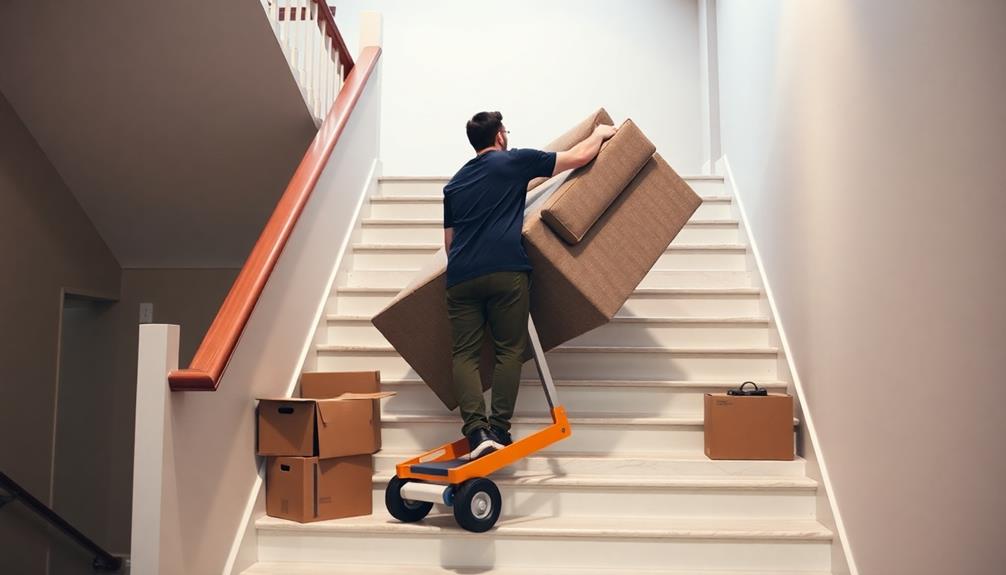
When tackling the challenge of getting heavy furniture up stairs, teamwork is essential. You'll want at least two partners, one at each end, to maintain control and balance while moving. A stair dolly specifically designed for this task can make the process much easier, allowing you to navigate the stairs with heavy items more efficiently.
Before starting, protect both your furniture and the stairs. Use moving blankets or pads around banisters and on the steps to prevent scratches and damage during your move.
As you lift and maneuver, clear communication between you and your partner is vital. Make sure you're both on the same page with synchronized movements to avoid accidents.
If the furniture feels particularly heavy or bulky, don't hesitate to take breaks on the stairs. Reassessing your situation can help prevent fatigue and make the process smoother.
Moving Down Stairs
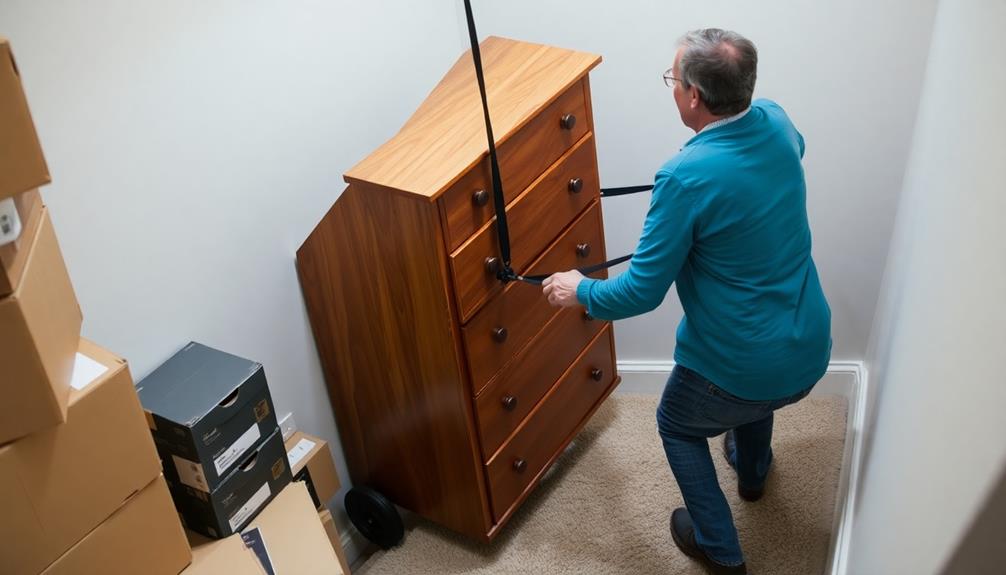
Descending stairs with heavy furniture can be just as tricky as going up, so having at least two people is essential for maintaining balance and control.
Start by using a hand truck or a stair dolly designed for moving down stairs, which helps you manage the weight more effectively. Before you begin, protect the furniture by covering banisters and the edges of the steps with blankets or padding to avoid damage.
When you're ready, communicate clearly with your partner about when to lift the item and how to coordinate your movements.
Position the furniture at a slight angle while descending; this technique allows gravity to assist you while still giving you enough control to navigate each step.
As you move down, maintain a firm grip to control the descent, ensuring that you both stay balanced throughout the process.
Post-Move Arrangements
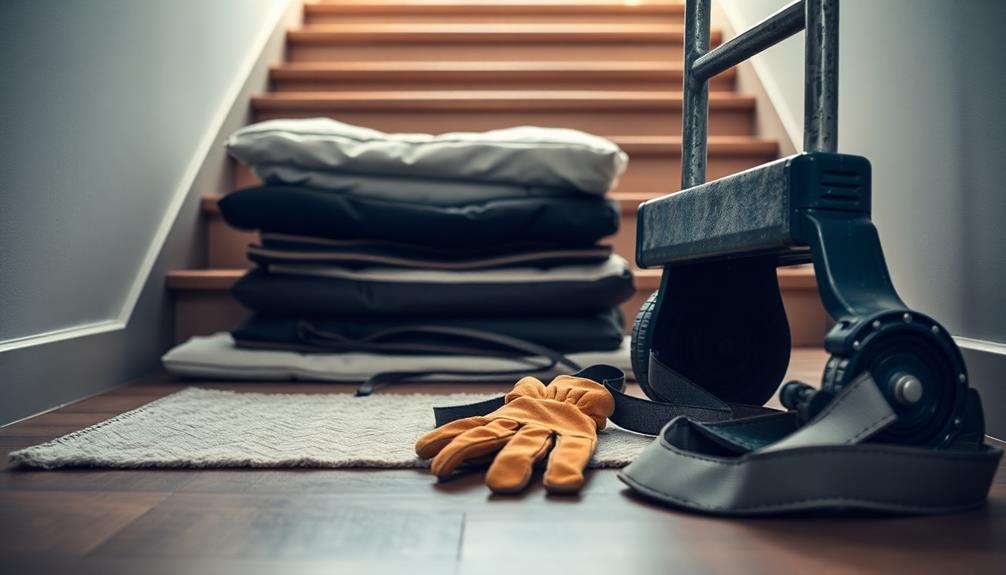
After you've successfully moved heavy furniture up the stairs, it's vital to assess each piece for any damage. Inspect each piece carefully, as identifying issues early on can save you from costly repairs.
If you've taken apart any items during the move, reassemble them promptly to restore their functionality and avoid confusion over missing parts.
Next, organize the furniture in your new space. Consider the flow and functionality of the area to enhance usability. Use furniture coasters under heavy items to protect your floors from scratches and dents, safeguarding their long-term preservation. This small step can make a significant difference in maintaining your flooring.
As you settle in, don't forget about post-move arrangements. It's imperative to manage packing materials and debris effectively. Responsible disposal of these items not only helps maintain a tidy living environment but also prevents clutter from accumulating.
Frequently Asked Questions
How Do You Move Heavy Furniture by Yourself Stairs?
To move heavy furniture by yourself, use a stair climbing dolly for easier transport. Secure the item, tilt the dolly back, and take deliberate steps to maintain balance and control throughout the process.
How to Get a Couch up the Stairs?
"Many hands make light work." To get a couch up the stairs, measure everything first, lift with your legs, communicate with your partner, and consider using a stair dolly for easier maneuvering.
How to Lift a Heavy Table by Yourself?
To lift a heavy table by yourself, clear the area, measure dimensions, and use proper lifting techniques. Consider furniture sliders or a dolly for easier movement, and disassemble it if it's too heavy to lift alone.
How to Move Heavy Furniture With Sliders?
To move heavy furniture with sliders, place them under each leg, ensuring the smooth side faces down. This reduces friction, making it easier to glide the item across surfaces without scratching or damaging your floors.
Conclusion
In the end, moving heavy furniture up and down stairs is all about preparation and technique. You might find that the same strategies you use to lift that old couch can help you tackle life's heavier challenges, too. Just as you navigate those stairs with care, remember to approach hurdles with patience and determination. Coincidentally, every successful move not only rearranges your space but also strengthens your resilience, making you more adept at handling whatever comes your way.
